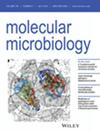Identification of EppR, a Second Repressor of Error-Prone DNA Polymerase Genes in Acinetobacter baumannii
IF 2.6
2区 生物学
Q3 BIOCHEMISTRY & MOLECULAR BIOLOGY
引用次数: 0
Abstract
Acinetobacter baumannii is an opportunistic pathogen causing several infections that are increasingly difficult to treat due to its ability to rapidly gain antibiotic resistances. These resistances can arise due to mutations through the activity of error-prone DNA polymerases, such as DNA polymerase V (DNA Pol V) in response to DNA damage. The regulation of the DNA damage response (DDR) in A. baumannii is not completely understood; the regulation of genes encoding multiple copies of DNA Pol V is not fully characterized. Through genome-wide mutagenesis, we have identified a novel TetR-like family regulator of the umuDC and umuC genes, which we have named Error-prone polymerase regulator (EppR). We have found that EppR represses the expression of the genes encoding DNA Pol V and itself through direct binding to an EppR motif in their promoters. Lastly, we show that EppR also regulates UmuDAb, previously identified as a regulator of genes encoding DNA Pol V. These two gene products are functionally required to ensure regulation of the expression of the two umuDC, the two umuC genes as well as the regulators umuDAb and eppR genes. With these results, we propose a model in which multiple transcription factors regulate the expression of all these genes.

鲍曼不动杆菌易出错DNA聚合酶第二抑制基因EppR的鉴定
鲍曼不动杆菌是一种机会致病菌,引起多种感染,由于其迅速获得抗生素耐药性的能力,这种感染越来越难以治疗。这些抗性可能是由于易出错的DNA聚合酶(如DNA聚合酶V (DNA Pol V))响应DNA损伤而产生的突变而产生的。鲍曼不动杆菌DNA损伤反应(DDR)的调控机制尚不完全清楚;编码DNA多拷贝Pol V的基因调控尚未完全确定。通过全基因组诱变,我们鉴定出了umuDC和umuC基因的一种新的类似于rt的家族调节剂,我们将其命名为易出错聚合酶调节剂(Error-prone polymerase regulator, EppR)。我们发现EppR通过直接结合启动子中的EppR基序来抑制编码DNA Pol V及其自身的基因的表达。最后,我们发现EppR还能调控UmuDAb,而UmuDAb先前被认为是编码DNA Pol v的基因的调节因子。这两个基因产物在功能上是必需的,以确保调控两个umuDC、两个umuC基因以及调节因子UmuDAb和EppR基因的表达。根据这些结果,我们提出了一个模型,其中多个转录因子调节所有这些基因的表达。
本文章由计算机程序翻译,如有差异,请以英文原文为准。
求助全文
约1分钟内获得全文
求助全文
来源期刊

Molecular Microbiology
生物-生化与分子生物学
CiteScore
7.20
自引率
5.60%
发文量
132
审稿时长
1.7 months
期刊介绍:
Molecular Microbiology, the leading primary journal in the microbial sciences, publishes molecular studies of Bacteria, Archaea, eukaryotic microorganisms, and their viruses.
Research papers should lead to a deeper understanding of the molecular principles underlying basic physiological processes or mechanisms. Appropriate topics include gene expression and regulation, pathogenicity and virulence, physiology and metabolism, synthesis of macromolecules (proteins, nucleic acids, lipids, polysaccharides, etc), cell biology and subcellular organization, membrane biogenesis and function, traffic and transport, cell-cell communication and signalling pathways, evolution and gene transfer. Articles focused on host responses (cellular or immunological) to pathogens or on microbial ecology should be directed to our sister journals Cellular Microbiology and Environmental Microbiology, respectively.
 求助内容:
求助内容: 应助结果提醒方式:
应助结果提醒方式:


